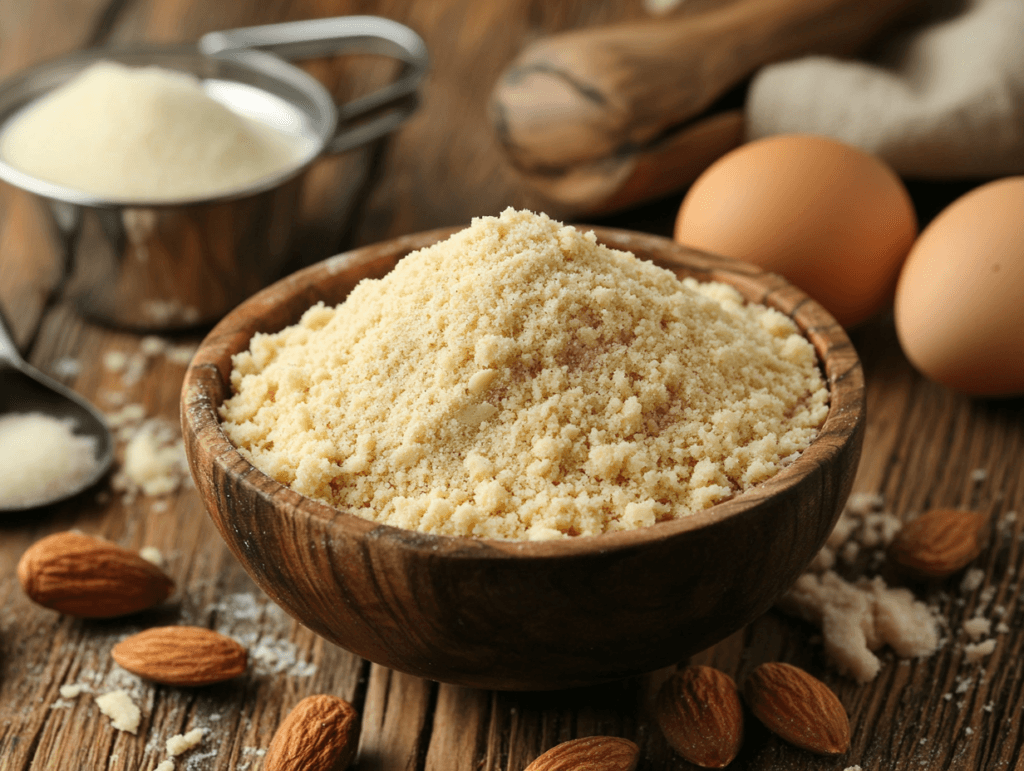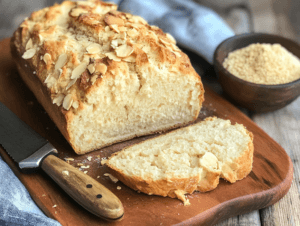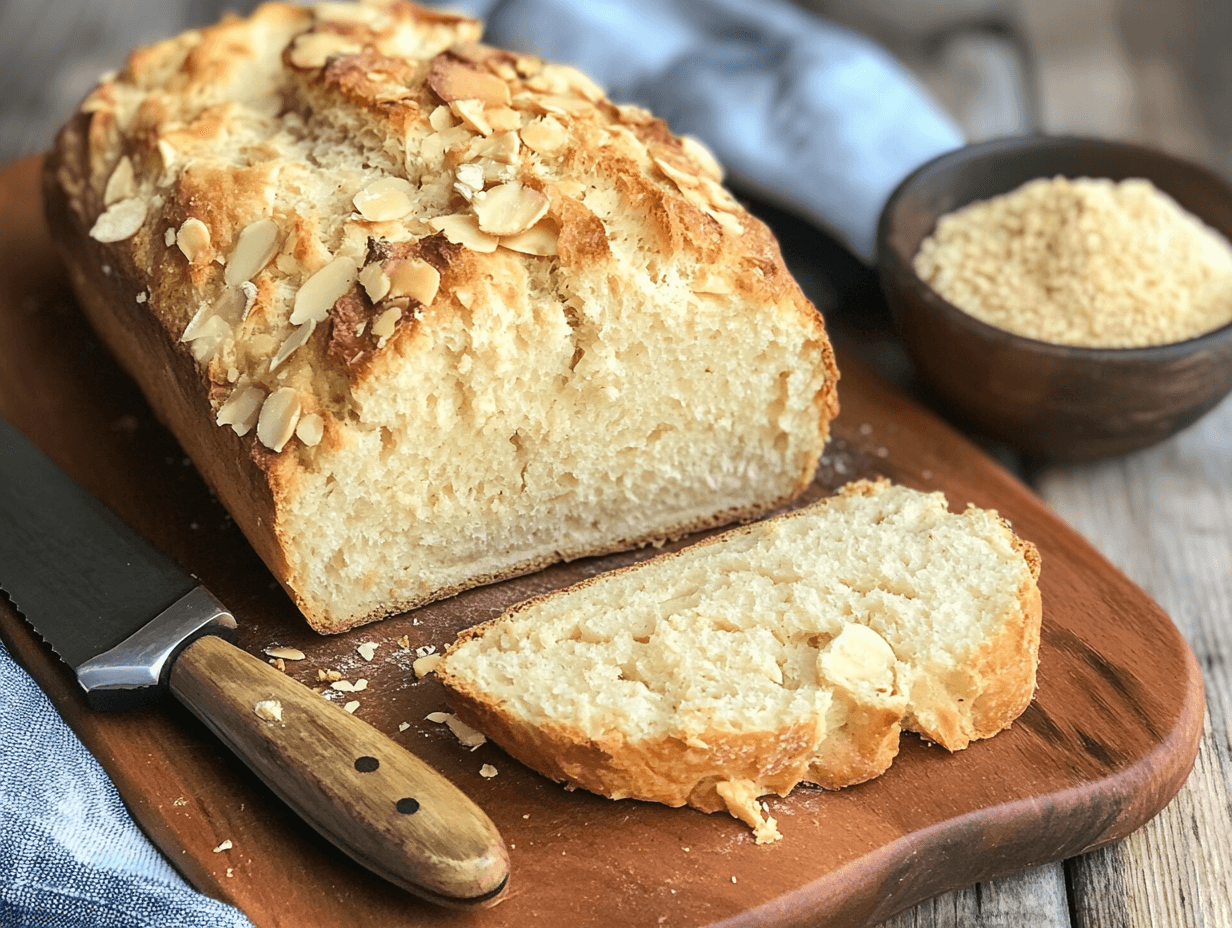Can you bake with almond meal instead of flour is a question that sparks curiosity for both seasoned bakers and beginners. Almond meal offers a world of possibilities, especially for gluten-free or low-carb recipes. But is it really as easy as swapping one for the other? Let’s dive in and explore how this versatile ingredient can transform your baked goods.
Table of Contents
What Is Almond Meal?
Understanding almond meal is the first step in using it effectively. This ingredient isn’t as mysterious as it might sound, and it could already be a pantry staple for some.
How Is Almond Meal Made?
Almond meal is simply ground almonds. The process involves blanching almonds to remove their skins and then grinding them into a fine, powdery texture. Unlike traditional wheat flour, almond meal keeps the almonds’ natural oils, giving it a rich, nutty flavor.
Think of it as almonds in a powdered form, ready to work their magic in the kitchen.
“Almond meal adds a wholesome, nutty twist to every recipe it touches. It’s like giving your baked goods a personality boost.”
Differences Between Almond Meal and Almond Flour
Here’s where things can get confusing.
Here’s where things can get confusing. Almond meal and almond flour are not identical. While almond flour is typically finer and made from blanched almonds with the skins removed, almond meal may include the skins and has a slightly coarser texture.
While almond flour is more common in recipes like macarons, almond meal works well in heartier baked goods such as muffins or pancakes.

Why Use Almond Meal Instead of Flour?
The big question: why make the switch to almond meal? Beyond curiosity, there are some compelling reasons.
Health Benefits of Almond Meal
Almond meal isn’t just a substitute; it’s a superfood. Packed with protein, healthy fats, and fiber, it turns baked treats into nutrient-rich snacks. Unlike refined wheat flour, almond meal has a low glycemic index, meaning it won’t spike your blood sugar.
Imagine cookies you can feel good about eating!
Environmental Advantages of Almond-Based Baking
Baking with almond meal isn’t just good for your body—it’s good for the planet, too. Almond meal production uses fewer chemicals compared to traditional flour milling. Plus, it’s a win for gluten-free and paleo enthusiasts looking for eco-friendly alternatives.
“Switching to almond meal is like baking for a cause—your health and the environment both get a slice of the pie.”
Want to explore a delicious treat using almond meal? Check out the ultimate guide to chocolate brownie with almond meal for a rich and satisfying dessert option.
Common Problems When Baking with Almond Meal
Even though almond meal is fantastic, it’s not without its quirks. If you’ve ever had a recipe flop, you know how frustrating it can be. Let’s troubleshoot some common challenges.
Texture Challenges
Almond meal’s texture is coarser than traditional flour, so it doesn’t bind the same way. This can lead to crumbly cookies or dense cakes. Adding a binding agent, like eggs or flaxseed, can help hold things together.
Taste Adjustments
The nutty flavor of almond meal might be a bit overpowering in delicate recipes. To balance this, pair it with complementary flavors like vanilla, cinnamon, or citrus.
Moisture Content Issues
Almond meal tends to hold moisture, which can make baked goods soggy. The solution? Reduce other liquids in the recipe and bake at a slightly lower temperature for a longer time.
How to Adjust Recipes for Almond Meal
Baking with almond meal isn’t a direct swap for wheat flour. It’s like learning a new language in the kitchen, but once you get it, the results are amazing.
Changing Ratios for Almond Meal
Start by replacing 25% to 50% of the flour in a recipe with almond meal. Too much almond meal can throw off the texture, so moderation is key.
Using Binding Agents to Improve Texture
Since almond meal lacks gluten, you need something else to bind the ingredients. Eggs, xanthan gum, or chia seeds soaked in water are great options.
“Think of binding agents as the glue that holds your baked masterpiece together.”
Balancing Sweetness and Flavors
Almond meal brings its natural sweetness to recipes, so you might need less sugar. Taste-test as you go, and don’t be afraid to experiment with spices or extracts.
Best Recipes to Try with Almond Meal
Ready to put almond meal to the test? Here are some easy, delicious recipes to kick-start your baking adventures.
Almond Meal Cookies
These cookies are chewy, nutty, and melt-in-your-mouth good. They’re perfect for a quick snack or a thoughtful homemade gift.
Almond Meal Pancakes
Who doesn’t love pancakes? Almond meal pancakes are fluffy, gluten-free, and packed with protein to fuel your morning.
Almond Meal Cakes
From chocolate to lemon, almond meal cakes are moist and flavorful. Try a simple almond meal cake topped with fresh berries for a show-stopping dessert.
Gluten-Free Baking with Almond Meal
If you’re diving into the world of gluten-free baking, almond meal is a game-changer. It opens up endless possibilities for creating delicious treats without compromising texture or flavor.
Understanding Gluten-Free Baking Principles
Baking without gluten can feel like venturing into uncharted territory. Gluten gives traditional flour its structure, elasticity, and chewiness. Without it, baked goods can fall apart or turn out dense. Almond meal steps in as a perfect gluten-free option, adding richness and a nutty taste.
But remember, almond meal alone might not provide enough structure. Combining it with other gluten-free flours, like coconut flour or tapioca starch, can create a balanced mix.
Combining Almond Meal with Other Gluten-Free Flours
Almond meal pairs beautifully with lighter gluten-free flours. Coconut flour, for instance, soaks up moisture and complements almond meal’s richness. A general rule of thumb is to mix flours in a 3:1 ratio—three parts almond meal to one part coconut flour.
This combination works wonders for muffins, cakes, and even gluten-free bread. Just don’t forget to adjust the liquid and binding agents to match the consistency of traditional doughs.
“Gluten-free baking is like building a puzzle. Each ingredient plays a crucial role in creating the perfect piece.”
Nutritional Comparison: Almond Meal vs. Traditional Flour
When you compare almond meal to regular flour, it’s clear they’re worlds apart in terms of nutrition. Whether you’re health-conscious or just curious, understanding these differences can help you make smarter baking choices.
Caloric and Nutritional Differences
Almond meal is denser in calories than wheat flour, but it’s packed with healthy fats, protein, and fiber. It’s like the superhero of the baking aisle—delivering energy and nutrients in every bite.
On the other hand, traditional flour is mostly carbs with little nutritional value. It’s the workhorse of the pantry but lacks the nutritional depth of almond meal.
Here’s a quick comparison:
| Nutrient | Almond Meal (1/4 cup) | Wheat Flour (1/4 cup) |
|---|---|---|
| Calories | 150 | 110 |
| Protein | 6g | 3g |
| Fiber | 3g | 1g |
| Carbs | 6g | 23g |
| Fats | 14g | 0.5g |
Effects on Blood Sugar and Digestion
Almond meal’s low glycemic index makes it a great choice for people watching their blood sugar. Unlike wheat flour, which can cause spikes, almond meal helps maintain steady energy levels. Plus, the fiber content supports healthy digestion and keeps you feeling full longer.
Can You Bake Bread with Almond Meal?
Ah, bread—the ultimate comfort food. But can almond meal deliver the same soft, chewy goodness we expect from a traditional loaf?
Exploring Bread Recipes with Almond Meal
Almond meal works wonderfully for certain types of bread, especially dense, hearty loaves like banana bread or zucchini bread. It’s less ideal for airy, yeasted bread since it lacks gluten, but you can still get creative.
For example, almond meal combined with eggs, baking powder, and a touch of psyllium husk creates a fantastic gluten-free sandwich bread. It won’t rise like traditional bread, but it’s flavorful and satisfying in its own way.
Tips for Achieving the Right Crust and Rise
To mimic the texture of traditional bread, you’ll need a few tricks:
- Add Eggs: They provide structure and lift, acting as a substitute for gluten.
- Use Psyllium Husk: This magical ingredient absorbs water and creates elasticity, aking the bread less crumbly.
- Bake Low and Slow: Almond meal burns more easily, so reduce your oven temperature slightly and extend the baking time.
“Baking bread with almond meal is like painting with a new brush—you’ll discover a unique masterpiece every time.”
Frequently Asked Questions About Almond Meal Baking
If you’re curious about other gluten-free baking options, explore can I use almond flour instead of all-purpose flour for brownies to learn how almond flour works in rich desserts like brownies.
There’s no shortage of curiosity when it comes to almond meal. Let’s answer some of the most common questions.
Can Almond Meal Replace All-Purpose Flour in Any Recipe?
Not exactly. Almond meal works best in recipes specifically designed for it or those that don’t rely heavily on gluten. While you can experiment with partial substitutions, it’s not a one-to-one replacement.
Does Almond Meal Work for Savory Dishes?
Absolutely! Almond meal isn’t just for cookies and cakes. Use it to bread chicken, thicken sauces, or even make savory tarts. Its nutty flavor adds depth to all kinds of dishes.
How Long Does Almond Meal Last?
Stored properly, almond meal can last up to six months in the refrigerator or a year in the freezer. Keep it in an airtight container to prevent it from absorbing moisture or odors.
Expert Tips for Baking Success with Almond Meal
Baking with almond meal isn’t just about swapping ingredients—it’s an art. With a few tips and tricks, you can master the nuances and create bakery-worthy treats right at home.
Ensuring Proper Storage
Almond meal’s natural oils make it prone to spoilage. To keep it fresh, store it in an airtight container in a cool, dark place. Better yet, pop it into the fridge or freezer for longer shelf life. Just let it come to room temperature before using it in recipes.
“Treat almond meal like a treasure—store it well, and it’ll reward you with incredible results every time.”
Sifting and Preparing Almond Meal
Almond meal can clump due to its oil content, so sifting it before adding it to your batter is a good idea. This ensures a smooth texture and even distribution.
Pro tip: Use a fine-mesh sieve or a sifter for the best results. If it feels too coarse, pulse it in a food processor for a few seconds to refine it further.
Trial and Error: Learning Through Experience
Let’s be honest—not every almond meal recipe will turn out perfect on the first try. And that’s okay! Baking is as much about experimenting as it is about following instructions. Adjust liquids, binding agents, and baking times until you find the sweet spot.
Where to Buy Quality Almond Meal
Finding high-quality almond meal can make or break your recipes. But don’t worry—there are plenty of options to ensure you get the best product.
Top Brands for Almond Meal
Look for trusted brands that specialize in gluten-free or natural baking ingredients. Brands like Bob’s Red Mill or King Arthur Baking Company offer consistent quality. Always check the label for added ingredients—pure almond meal should have just one: almonds.
DIY: Making Almond Meal at Home
If store-bought almond meal feels too pricey, why not make your own? It’s simple and cost-effective. Here’s how:
- Start with Raw Almonds: Choose blanched almonds for a finer texture or unblanched for a rustic look.
- Grind in Small Batches: Use a food processor or high-speed blender. Pulse in short bursts to avoid turning the almonds into butter.
- Sift the Meal: Remove any larger chunks to achieve an even texture.
Homemade almond meal is fresher and gives you control over its coarseness. Plus, it’s super satisfying to create it yourself!
Conclusion: Unlocking Creativity with Almond Meal
Almond meal isn’t just a flour substitute—it’s a gateway to creative, flavorful, and healthier baking. Whether you’re whipping up cookies, pancakes, or savory dishes, this versatile ingredient brings something special to the table.
Yes, it has its quirks, but those challenges are what make it so exciting to work with. From gluten-free treats to low-carb delights, almond meal empowers bakers to think outside the box. So grab that bag of almond meal, roll up your sleeves, and let your kitchen become a playground of possibilities!
“Almond meal is like the adventurous friend who gets you to try new things—you might stumble at first, but the journey is always worth it.”

Almond Meal Cookies
Equipment
- Mixing Bowl
- Whisk
- Baking Sheet
- Parchment Paper
Ingredients
- 1 1/2 cups almond meal
- 1/2 cup coconut sugar (or brown sugar)
- 1 large egg
- 1/4 cup melted coconut oil
- 1 tsp vanilla extract
- 1/2 tsp baking soda
- 1/4 tsp salt
- 1/2 cup dark chocolate chips
Instructions
- Preheat oven to 350°F (175°C) and line a baking sheet with parchment paper.
- In a bowl, mix almond meal, sugar, baking soda, and salt.
- In another bowl, whisk egg, coconut oil, and vanilla. Combine with the dry ingredients.
- Fold in the chocolate chips.
- Scoop dough onto the baking sheet and flatten slightly.
- Bake for 10-12 minutes until golden brown.

